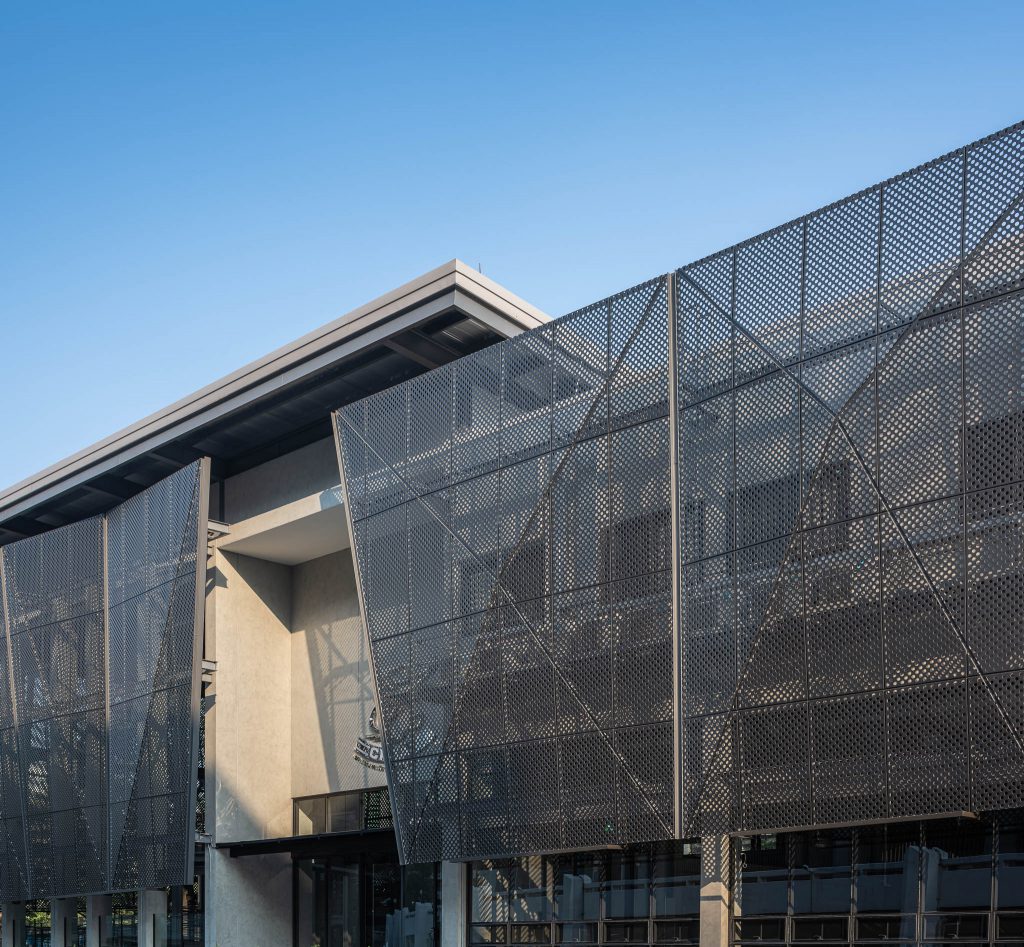At the new Boccia National Field Training Center, the design team of pbm has interpreted the concept of simplicity and imperfection into the façade by applying the shape of a scalene triangle.
Text: Nathanich Chaidee
Photo: Yamastudio
Download the online journal Issue 02 More Than Skin Click here
Boccia (บอคเซีย) คือหนึ่งในกีฬาความหวังที่ตัวแทนนักกีฬาคนพิการชาวไทยซึ่งเข้าร่วมการแข่งขันในระดับโลกอย่างพาราลิมปิกเกมส์ และคว้าเหรียญรางวัลติดมือกลับมาฝากแฟนกีฬาชาวไทยอย่างสม่ำเสมอ ศูนย์ฝึกกีฬาบอคเซียแห่งชาติ สมาคมกีฬาคนพิการทางสมองแห่งประเทศไทย จึงถูกออกแบบและก่อสร้างเพื่อรองรับการฝึกซ้อมและอำนวยความสะดวกสำหรับนักกีฬาคนพิการโดยเฉพาะ เพื่อเตรียมพร้อมสำหรับการแข่งขัน ไปจนถึงการเป็นพื้นที่เรียนรู้และเผยแพร่เทคนิคกีฬาบอคเชียให้กับนักกีฬาคนพิการทั้งในประเทศและเพื่อนบ้านภูมิภาคอาเซียน
โครงการครั้งนี้เกิดขึ้นจากความร่วมมือของการกีฬาแห่งประเทศไทยหัวหมาก โดยมี สิงห์ เอสเตท เป็นเจ้าภาพในการให้การสนับสนุน จึงได้ชักชวน pbm ซึ่งเคยร่วมงานกันในฐานะผู้ออกแบบสำนักงานใหญ่ บริษัท บุญรอด บริวเวอรี่ ณ ตึกสิงห์ คอมเพล็กซ์ มาเป็นสถาปนิกผู้ออกแบบอาคารศูนย์กีฬาบอคเซียแห่งชาติในครั้งนี้
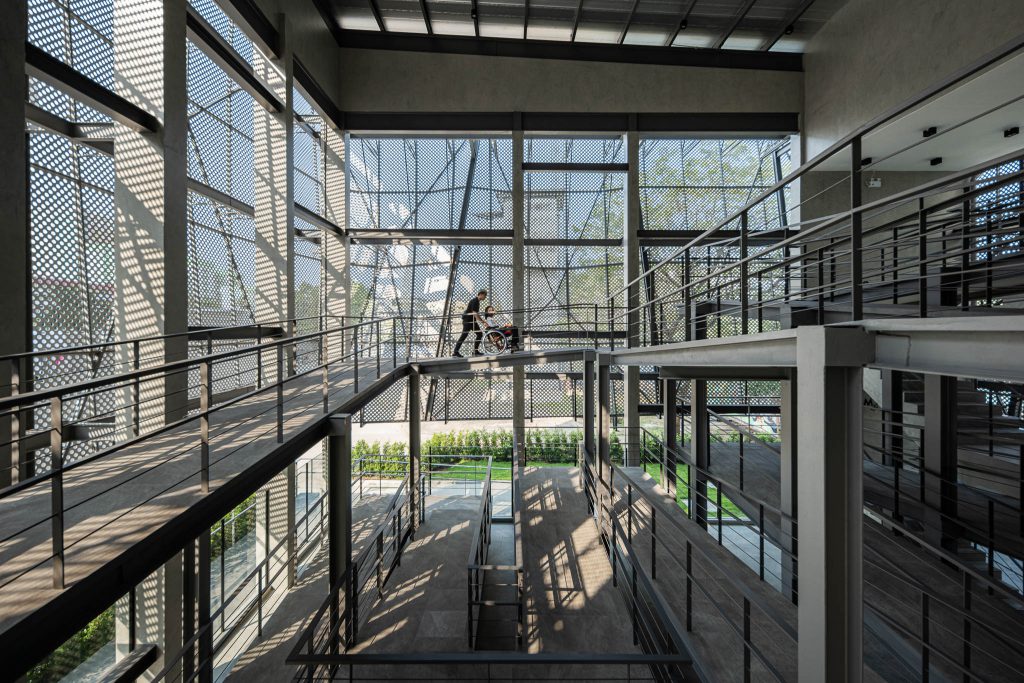
Photo: Yamastudio
“โครงการนี้เป็นเหมือนกับการกุศล วัสดุต่างๆ ส่วนหนึ่งก็ได้รับจากการร่วมบริจาคจากหลายหน่วยงาน จึงเกิดเป็นข้อจำกัดบางอย่างที่ทำให้เราต้องออกแบบเพื่อให้รองรับกับวัสดุนั้นๆ ด้วย รวมไปถึงกรอบอาคารหรือความต้องการใช้งานพื้นที่ต่างๆ มันเลยไม่ได้เริ่มต้นจากศูนย์ไปเสียทีเดียว”
โจทย์ที่ทาง pbm ได้รับมา คือการออกแบบอาคารให้กับนักกีฬาบอคเซีย โดยชั้นล่างเป็นสนามซ้อมจำนวน 4 สนาม และชั้นบนเป็นพื้นที่พักนักกีฬา แนวคิดหลักจึงเน้นการเข้าถึงของผู้ใช้ผ่านพฤติกรรมการใช้งานรถเข็น งานสำคัญสำหรับทีมออกแบบจึงเป็นเรื่องการออกแบบทางลาดขนาดใหญ่ในโถงอาคารซึ่งเป็นตัวเชื่อมต่อเส้นทางสัญจรภายในอาคารในแนวดิ่งให้ใช้งานได้อย่างสะดวกสบาย และเป็นเส้นสายที่สร้างลักษณะเด่นที่ แสดงออกถึงความภาคภูมิใจทั้งกับกีฬาบอคเซียและตัวนักกีฬาเอง
ข้อกำหนดสำคัญในส่วนการออกแบบสนามกีฬา นั่นคือพื้นที่ใช้สอยภายในสนามซ้อมที่ควรหลีกเลี่ยงไม่ให้มีเสาซึ่งจะกีดขวางภายในบริเวณทั้งหมด การออกแบบและจัดการโครงสร้างอาคารจึงเลือกใช้โครงสร้างเหล็กพาดช่วงยาวสำหรับรับน้ำหนักของชั้นบนซึ่งเป็นพื้นที่พักนักกีฬา ไปพร้อมกับการออกแบบบริเวณภายในพื้นที่พักให้โปร่งโล่ง มีการระบายอากาศที่ดี และให้ผู้ใช้งานได้สัมผัสกับธรรมชาติระหว่างการพักผ่อนหลังจากการฝึกซ้อม
ด้วยรูปทรงของอาคารรูปสี่เหลี่ยมผืนผ้าสัดส่วนแปลกตาที่มีปัจจัยบังคับจากขนาดของสนามซ้อมภายใน และเส้นสายของอาคารที่สะท้อนให้เห็นความเป็นเส้นนอนและเส้นเฉียงของทางลาด ทีมออกแบบจึงมีแนวคิดที่จะใช้ façade สำหรับปกคลุมรูปด้านของอาคารเพื่อให้ตัวอาคารดูมีมิติและน่าสนใจมากยิ่งขึ้น ด้วยแนวความคิด “ความงามของความไม่สมบูรณ์” ที่ดึงเอาความเคลื่อนไหวในแบบมั่นคงและเรียบง่ายอย่างเช่นอากัปกิริยาของนักกีฬาบนรถเข็น
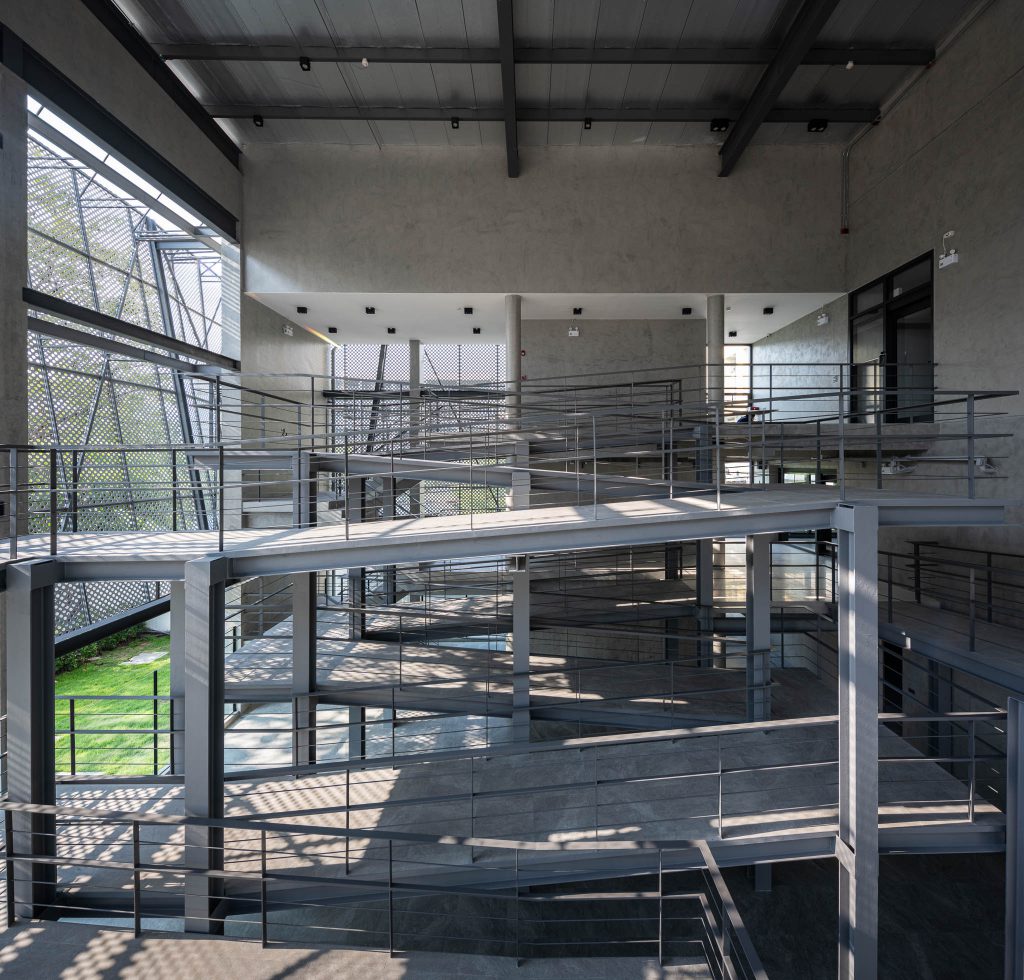
Photo: Yamastudio
“เริ่มจากผู้มาเยือนอาคารจะต้องเห็นความมั่นคง เริ่มต้นจากรูปร่างและรูปทรงของตัวอาคารที่เป็นสี่เหลี่ยมผืนผ้า เส้นนอนที่มั่นคงด้วยตัวของเส้นสายเอง เราก็เอาความมั่นคงนี้มาตีความต่อถึงวัสดุประกอบอาคาร เพื่อให้ผสมผสานอย่างดีกับความเรียบง่าย”
ความเรียบง่ายจึงถูกแปลความผ่าน façade ออกมาเป็นรูปร่างสามเหลี่ยมด้านไม่เท่า เมื่อผสานกับแนวคิดเรื่องความไม่สมบูรณ์แบบของรูปทรง ความงามตามธรรมชาติจึงเกิดขึ้นจากแต่ละเหลี่ยมมุมที่ไม่เท่ากันของ façade พร้อมกับความเคลื่อนไหวของพื้นผิวภายนอกอาคารเมื่อกระทบกับแสงอาทิตย์ตลอดวัน
ลำดับต่อมาจึงเป็นเรื่องการเลือกวัสดุสำหรับ façade โดยเลือกจากวัสดุที่สามารถหาได้ง่ายจากท้องตลาด สถาปนิกจึงเลือกใช้งานแผ่นอะลูมิเนียมเจาะรู (Perforated Aluminium) โดยดึงเอาอัตลักษณ์รูปวงล้อของโลโก้องค์กรบอคเซียที่สื่อให้เห็นถึงการเคลื่อนไหวของนักกีฬาบนรถเข็นมาเป็นแพทเทิร์นของการเจาะ “เราไปเห็นโลโก้ขององค์กรที่เห็นความเฉพาะของกีฬา และเราก็เห็นว่าถ้าดึงโลโก้ตัวนี้มาเป็นแพทเทิร์น ก็จะยิ่งช่วยสนับสนุนให้นักกีฬามีความมั่นใจมากขึ้นในการทำกิจกรรมบนรถเข็นหรือวงล้อตัวนี้ และคนที่ใช้งานอาคารก็จะเห็นภาพจำลองเหมือนเราได้อยู่ในพื้นที่ของนักกีฬาผ่านวงล้อนับพันที่อยู่ภายในพื้นที่”
ปฏิสัมพันธ์ระหว่างผู้ใช้งานอาคารกับพื้นที่ภายในเกิดขึ้นผ่าน façade ที่เป็นเหมือนม่านกรองแสงขั้นแรกก่อนเข้าสู่ตัวอาคาร แสงธรรมชาติที่ลอดผ่าน façade ซึ่งแตกต่างตลอดวันสร้างความเคลื่อนไหวส่งต่อตกกระทบลงบนพื้นผิวในระนาบต่างๆ สร้างให้อาคารกลับมามีชีวิตชีวาภายใต้โครงสร้างของเส้นสายที่มั่นคง

Photo: Yamastudio
ประโยชน์ใช้สอยอีกประการของแผ่น façade อะลูมิเนียมเจาะรูเป็นเรื่องของการประหยัดพลังงาน ซึ่งทำหน้าที่เชื่อมต่อระหว่างธรรมชาติของบริบทที่รายล้อมตัวอาคารเข้ามาสู่ภายในอาคาร จึงสามารถถ่ายเทอุณหภูมิ ลมที่พัดกระทบผิวหนัง และการระบายอากาศภายในพื้นที่ได้ดี เพิ่มความรู้สึกที่เป็นธรรมชาติของการใช้งานพื้นที่ภายในอาคารได้ดียิ่งขึ้น ความท้าทายสำหรับสถาปนิกในงานออกแบบ façade อาคารในครั้งนี้เป็นเรื่องของฟอร์มอาคารที่ความยาวและขนาดใหญ่เป็นพิเศษ จึงจำเป็นต้องออกแบบอาคารเพื่อสร้างสรรค์สัดส่วนอาคารให้ดูกระชับและสวยงามมากยิ่งขึ้น และสร้างความสม่ำเสมอให้กับทั้งอาคารกลายเป็นเรื่องราวเดียวกัน

Photo: pbm
façade ของอาคารศูนย์ฝึกกีฬาบอคเซียแห่งนี้ นอกเหนือจากการสร้างสรรค์ลีลาจากความเคลื่อนไหวของแสงธรรมชาติที่เปลี่ยนแปลงไปตลอดทั้งวันผ่านเปลือกอาคาร คุณค่าจากงานออกแบบยังส่งผลทางจิตวิทยาสำหรับผู้ใช้งานหลักอย่างนักกีฬาคนพิการ ให้ความรู้สึกมั่นใจในการฝึกซ้อม ลงแข่งขัน หรือการทำกิจกรรมต่างๆ ภายในอาคาร พร้อมกันกับคุณค่าของการทำงานที่ส่งกลับคืนให้กับสถาปนิกที่ว่า มุมมองและทักษะในเรื่องการออกแบบและแก้ปัญหารูปทรงของอาคารครั้งนี้ เป็นทั้งเรื่องการส่งเสริมภาพลักษณ์ให้กับองค์กร ไปพร้อมกับการสร้างคุณภาพชีวิตให้กับผู้ใช้งานให้เกิดขึ้นได้จริงผ่านงานออกแบบสถาปัตยกรรม
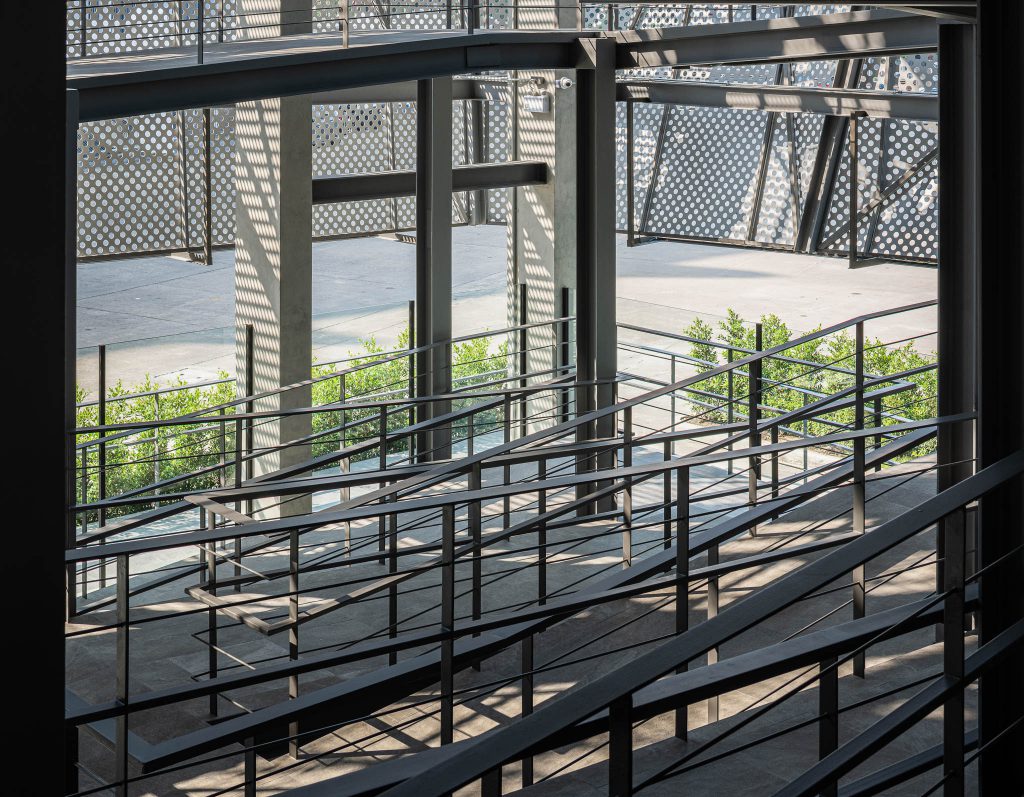
Photo: Yamastudio
Boccia is one of the sports where Thai athletes have always won medals at the Paralympic Games. Operated under the Cerebral Palsy Sports Association of Thailand, the new Boccia National Field Training Center is specifically designed and constructed to accommodate the training programs and facilities for athletes with disabilities. The training center prepares the athletes for competition and functions as a space that educates and promotes Boccia for broader national and regional recognition.
The project is a collaborative effort between the Sports Authority of Thailand (Huamark) and Boon Rawd Brewery. Having worked with PBM for its headquarters at Singha Complex, Boon Rawd Brewery then asked the firm to be the project’s architect. “This is a charity project, and the construction materials are donations from many different agencies. That becomes somewhat a limitation that forces us to develop the design according to the materials we have, including the plan and the requirements for spatial usages, so we didn’t exactly start from zero.” Says the architect.
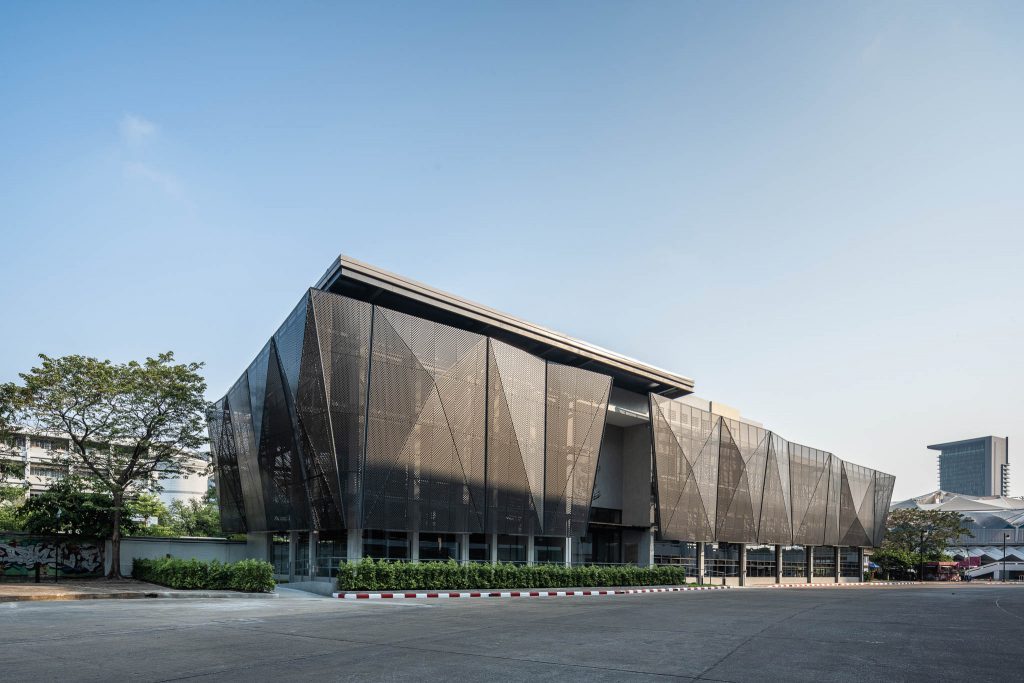
The brief is to design a building for Boccia athletes. The first floor hosts four training fields while the accommodation for athlete accommodation occupies the space on the upper floor. The design concept of accessibility for wheelchair users who are also primary users of the building comes with a challenge. The PBM team has to design a series of large indoor ramps that link the entire vertical circulation together, making the building’s access as convenient as possible. The ramps become an integral element of the building’s physical character, expressing its pride in the sports and the athletes.
One of the vital requirements of sports field architecture and design is the absence of columns in the training areas. The design and management of the building’s structure rely on the long-span steel structure, which can bear the weight of the upper floor where the athlete accommodation is located. The design grants the living units and common areas efficient natural ventilation, allowing users to relax from the surrounding natural elements during their breaks from training. The rectangular form with unusual proportions is defined by the functionally derived sizes of the training fields and the ramps’ horizontal and inclined lines. With the intention for the façade to bring more exciting dimensions to the building’s outer appearance, the design team interprets the ‘beauty of imperfection’ concept into the solid and straightforward movements of how athletes operate their wheelchairs.
“Visitors will see and sense the solidity of the building, from the rectangular form and shape to the stable horizontal lines. We further interpret this stability into construction materials, which also convey and blend well with the notion of simplicity.” Here the concept of simplicity and imperfection gets translated into the façade with the shape of a scalene triangle. The structure’s design renders a natural beauty of the geometric form’s unequal sides, complemented with the dynamic movements of the surface when interacted with sunlight at different times of the day.
The façade’s materials are all locally available, including perforated aluminum. Inspired by the Boccia Association’s logo, which conveys athletes’ movements on wheelchairs, the design team creates a pattern on the aluminum’s perforated surface. “We saw the logo and how it represented the particular characteristics of the sports and thought that if we used that with the pattern, it could give a sense of assurance for the athletes when they’re using their wheelchairs when they engage in different kinds of activities. Through this wheel-inspired perforated pattern, building’s users can experience the feeling of being a part of the training fields.”
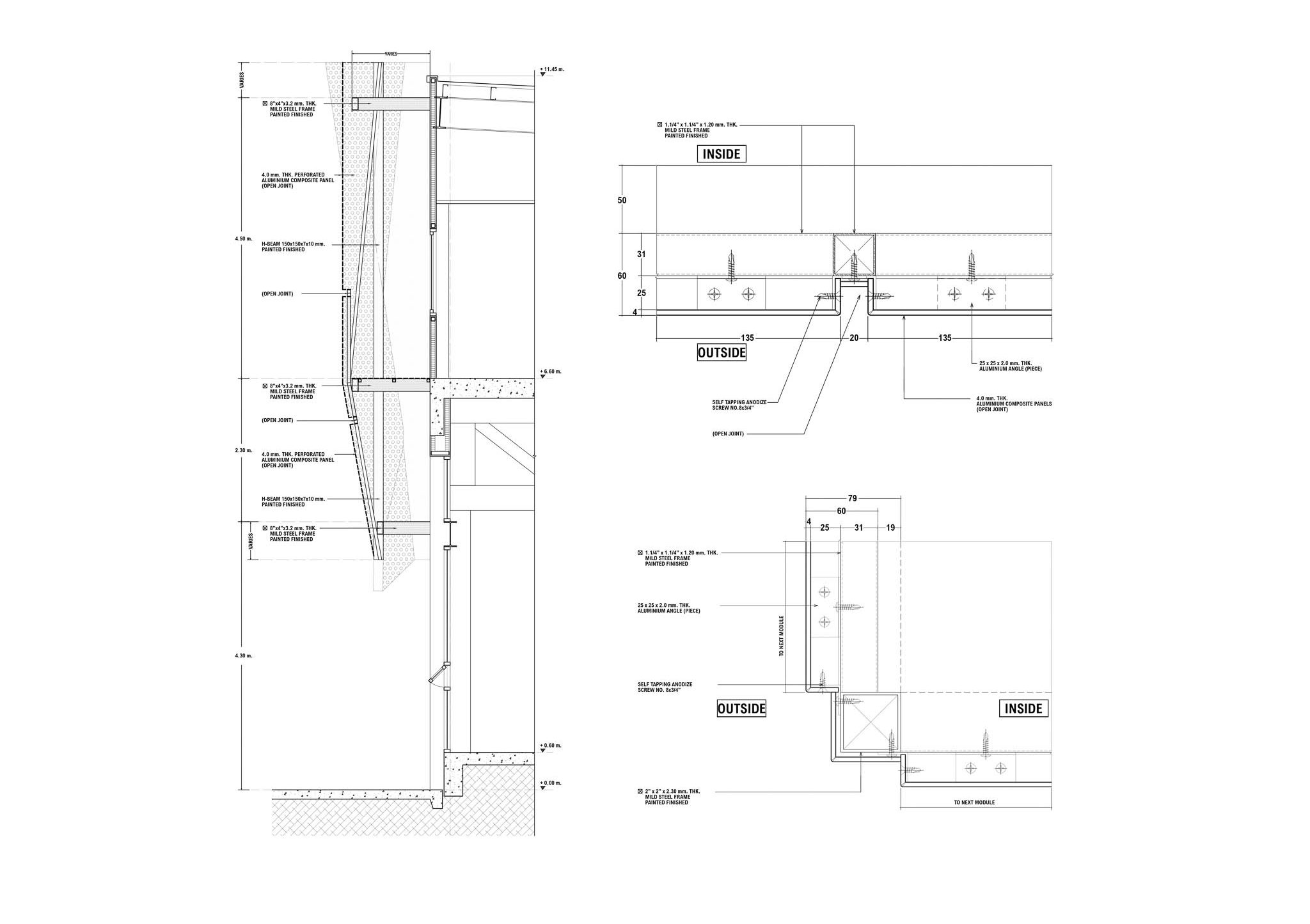
Photo: pbm
The interactions between users and interior space occur through the façade, which serves as the first layer of sun filtration for the building. Natural light coming through the architectural element alters throughout the day, bringing dynamic effects to different planes and surfaces, adding life to the architecture with gradually moving visible lines. Another function of the perforated aluminum façade is its energy-saving ability. It also serves as an interface that brings in the surrounding natural elements to the interior program. The circulated air means the balanced transfer of temperature, airflow, and internal ventilation. It enhances the presence of nature in the interior functional spaces. One of the most significant challenges of this façade design is the extra length and large size, which requires the architectural design to have an even more concise and visually appealing form while keeping the building and the enveloping composition into one unanimous narrative.
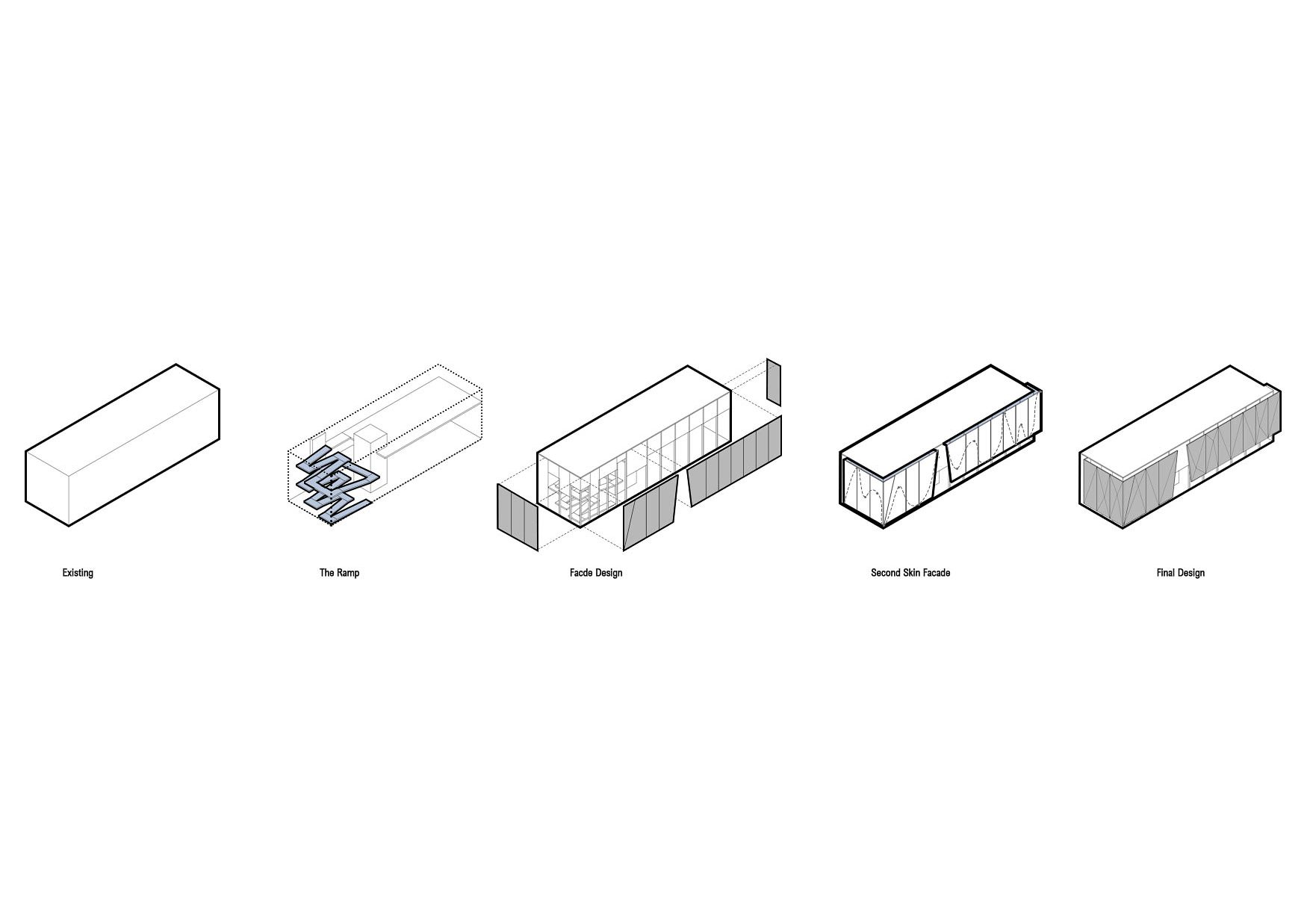
Photo: pbm
The façade of the Boccia Training Center enlivens the constant movements of natural light with its meticulously designed structure and surface. At the same time, the design’s psychological impacts on the athletes reassure the confidence in the training, competition, and participation in other activities. In return, for the architect, these values are rewarding for they are testaments of their visions, skills, and the power of architecture. The work they create has provided solutions that resolve all the limitations and restrictions, promoted the organization’s identity and image while successfully and meaningfully improved users’ quality of life at the same time.


